Ahmedabad-Mumbai Bullet Train Project
Ahmedabad-Mumbai Bullet Train Project

As the National High Speed Rail Corporation Limited (NHSRL) is building the India’s 1st high-speed rail corridor. It is connecting Ahmedabad and Mumbai, Indian industry has been urged to come up with an alternative to the high-tech machines that are needed to build viaducts at the desired pace, which at present are only made in China.
India’s trade with the neighbouring nation, China has been affected by the border tension in eastern Ladakh. The mega carrier as well as launcher machines are ubiquitous in large-scale connectivity projects of China.
Typically, under this technology, a vehicle carrying a full girder travels on a girder that is already launched to place the next girder. According to the report, the speed is nearly seven times that of the girder launching mechanism that is often used in India. While one-and-a-half girders are set up in a week’s time with this, the machines developed in China enable two girders a day. According to Achal Khare, MD NHSRL, each machine costs nearly Rs 70-80 crore and the Ahmedabad-Mumbai Bullet Train project will need up to 30 such machines. He further said to build 237 km in four years, there is no other way other than to use this technique.
Khare said these carrier-and-launcher machines are produced in China. So this is one of the challenges which the corporation has posed to the industry, including L&T and the academicians, that why can’t these machines be developed rather than imported from China. According to NHSRL MD, the machines are “no joke” as they are capable of carrying loads of 1000 tonnes-plus. At present, girders are carried in little segments by road. He further said even Japan, which is helping India with the high-speed rail corridor project, had not designed such machines. While China came up with them over its development of 25,000 km of high-speed rail, Khare said.
Similarly, the Ahmedabad Textile Research Institute has been asked by NHSRL to work on developing upholstery similar to the fire-retardant that is used in the Japanese high-speed Shinkansen system. Besides, several IITs are developing simulation software for electrical systems, etc., which at present, are the sole domain of foreign consultants engaged in railway as well as other such projects. Moreover, to replicate the Shinkansen technology, the industry and the engineering institutes have also been asked to study ballastless track. The corporation plans to hire management professionals and send them on secondment to JR East, which operates the Shinkansen. The aim behind this is that they learn how the system is managed and when they come back, they replicate that culture in India.
According to the report, India is to carry out around 75 per cent of the project’s construction through domestic firms. Usually, in projects of such a scale, contracts worth nearly Rs 80,000-90,000 crore, mostly in civil construction as well as track-laying, would go to Indian firms. The Ahmedabad-Mumbai bullet train corridor project, without normal inflation, factored in from the year 2015, is estimated at a cost of Rs 1.08 lakh crore. The Indian contractors have been told by NHSRCL to ensure that their staff, from rail-welding technicians to engineers, supervisors and motor car operators, get trained as well as certified by a reputed agency of Japan. While the national transporter insists the bullet train project is still on time for the December 2023 deadline, the sources quoted in the report said they are staring at a project completion date of December 2028.





